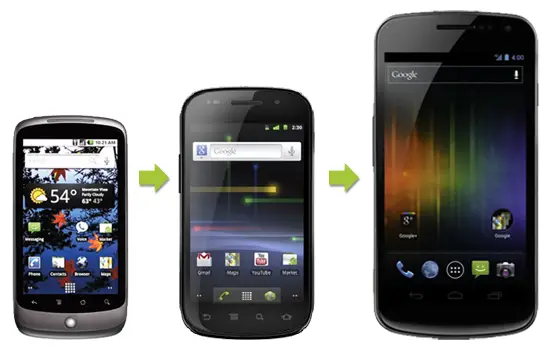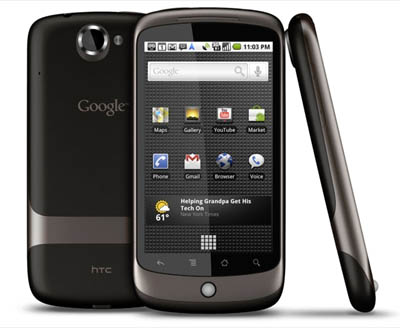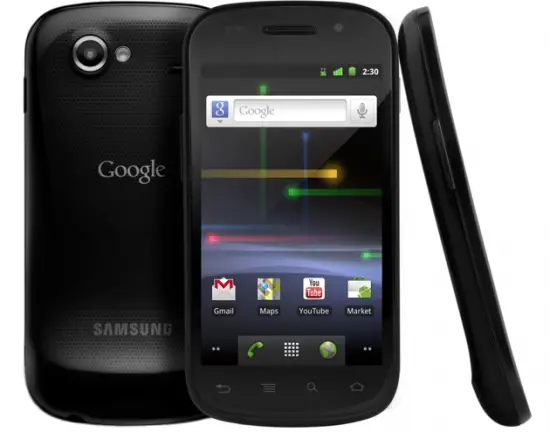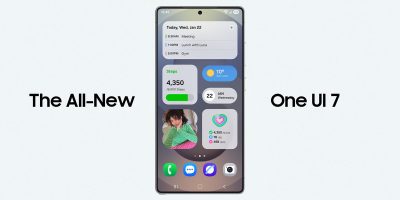So last week’s big announcements have all been wrapped up and we have the next edition of the Nexus phone on our hands – the Galaxy Nexus by Samsung. We’ve gotten a dual-core processor, Android 4.0 Ice Scream Sandwich, a 720p HD display and a lot more. But let’s take some time to see just how far we’ve come and reminisce how we got here.
Nexus One
The original Nexus phone – the Nexus One – was an exciting project. I can recall the day like it was literally yesterday, though I won’t go into grave detail. For specs, it boasted a 3.7 inch LCD display, a 1GHz single-core Snapdragon processor, 512MB of RAM, a 5 megapixel rear camera and one of my personal favorite features – a trackball that doubled as a multi-colored notification light.
Its aluminum unibody build made it feel as premium as any phone and we considered it our “iPhone killer”. But beneath all that was Android 2.0/2.1 Eclair, the first edition of Android to bring exciting things like Live Wallpapers, multiple accounts support and more. At the time, a 1GHz processor was about as desirable as a million dollars. Having suffered over a year of subpar performance due to slow processors, the 1GHz processor (not to mention general optimization in the OS) made Android run like a dream.
The Nexus One also marked the beginning of Google’s “phone store” experiment. Instead of selling the phone in respective carrier and retailer stores, they opted to sell it online without any major advertising. It all started with T-Mobile, but AT&T and several Canadian carriers would add support for the device.
Verizon was initially said to get the phone, but that never came to pass as they instead directed users to buy the DROID Incredible (which was and still is a very awesome phone for its time). Sprint also opted to push their then-revolutionary HTC EVO 3D. Worldwide it was made available by many carriers.
While those of us who check Android news every day were aware of the phone and bought it as soon as we could, we imagine sales performance wasn’t what Google expected. They soon closed the online store, though Nexus One devices continued to be sold. To this day, it remains many peoples’ main phone.
Nexus S
Though the Nexus One wasn’t a commercial success (it wasn’t meant to be), Google wanted to create a series, of sorts. Think of it as the iPhone of Google’s (not literally, of course). Finally, Android truly has its own flagship smartphone through the Nexus program that has OEMs clamoring for a shot at making the ultimate Google Experience phone.
The Nexus S is a fine phone. Still advertised and sold in stores today, it has a 1GHz Samsung Hummingbird processor, a 4 inch Super AMOLED curved display, an NFC chip, 16GB of internal storage, 512MB of RAM, a 5 megapixel camera with a VGA front-camera and more. Notably lacking from this phone is a notification light and a microSD card slot, something which affected many’s decision to buy it.
This release also marked the first time that a carrier put 4G radios inside of the phone as Sprint – a first time carrier for the series – put WiMax radios inside and dubbed it Nexus S 4G. Retailers and carriers were allowed to advertise it and sell it in stores, meaning it has a lot better chance at success than the original (though we’re not exactly sure where its numbers are right now).
With its introduction came the first commercial release of Gingerbread. While Gingerbread was seen as a disappointment at first due to beliefs that it would be transformed so extensively that regular Android users wouldn’t recognize it, it eventually grew on everyone.
UI improvements were more than just eye-candy as we saw a great boost in overall OS performance. It also brought with it darker tones and the very green that the Android mascot is painted with. It also boasted great new features such as a highly-improved text editing feature and a new battery usage visual.
While the Nexus S is a great phone, a lot of original owners didn’t see too much reason to upgrade. It still had a single-core processor and it was actually a downgrade in some areas. That’s not to take anything away from it – it’s a great phone – but this wasn’t the one we were looking for.
Galaxy Nexus
And then there’s the Galaxy Nexus, the second entry in the series by Samsung. This one was revealed last week in Hong Kong at a joint press conference of Google’s and Samsung’s. We were extremely blown away by the announcement and showing and it’s impressive what Samsung has achieved here.
This is one of the first phones with a 720p HD display. It’s 4.6 inches in size, but as it comes with Ice Cream Sandwich there are no hardware navigation buttons as those are replaced by buttons built into the software.
Like its predecessor, it has a curved glass display for ergonomics’ sake. Unlike the previous version which has a completely plastic chassis, it also uses aluminum in parts of its chassis to give it that premium, solid feel.
To keep the trend going, the launch of the Galaxy Nexus will mark the first release of Ice Cream Sandwich, the latest version of Android. Android 4.0 has applications and features to take advantage of everything inside the phone, including NFC-based content/document sharing.
It appears that a lot more carriers (at least here in the United States) will be willing to carry this phone. Verizon Wireless, who skipped the first two devices, have officially announced plans to carry it. Sprint has shown that they’re all-in with Nexus, too, as they went so far as to put 4G radios inside their Nexus S.
While Sprint, AT&T and T-Mobile have yet to announce any of their plans (Verizon is said to be a timed-exclusive carrier for the device), we expect all of them to carry the Galaxy Nexus at one point or another.
A Benchmark for OEMs
I feel it’s necessary to touch on what the Nexus series of devices is meant for. For consumers, those of us who want quick access to the latest versions of Android is the main driving point, but Google has created this series more for OEMs in certain ways.
The Nexus series provides a benchmark for OEMs to work with for their own phones. It’s a program that is supposed to inspire the evolution of phone technology and drive OEMs to create great, powerful Android phones showing them that it isn’t hard to put a great device out.
Nexus phones often showcase never-before-seen features not only in the Android world, but in smartphones period. 720p HD displays, barometers and NFC chips among other components inside the Galaxy Nexus are all relatively new to America, for instance, and Google hopes that OEMs will find value in using such components in some of their future products.
Google first changed the game with the Nexus One mentioned above. With a 3.7 inch display, a 1GHz processor, sufficient amounts of RAM, ROM and more, it was fairly advanced for its time. Shortly after, we saw many phones follow the model. Android phones were no longer seen as the ugly cousin around the block.
The Nexus One was the blueprint for great devices like the HTC EVO 3D, the HTC DROID Incredible and more. The Nexus S wasn’t too much different – it had a better GPU and CPU, a bigger and better display, a front-facing camera, an NFC chip and Android 2.3. Still, it introduced features that Google hoped OEMs would adopt.
By this time, many OEMs have outdone Google in the Nexus line. NVIDIA first introduced their dual-core chips to OEMs and showed them that they can put a lot more powerful chips inside phones while still minding the budget.
Since then, manufacturers like TI, Qualcomm and Samsung have created dual-core processors and have put them in many of their high-end phones. The industry will soon take it even further as NVIDIA looks to quickly usher in quad-core chips.
While the Nexus One’s purpose and effects on the industry weren’t immediately seen, you can now see how much it is responsible for the great devices being pumped out left and right today. You could even say that the original concept behind Nexus isn’t even needed anymore as technology seems to be self-evolving in the Android world, but of course we would never want the series to end.
Finally, A Flagship for Google
Up until now and for the foreseeable future, the battle has always simply been “Android vs iPhone”. Early criticism was that Google didn’t really have a flagship device even though they get tons of high-end offerings from tons of OEMs. Apple brings out roughly one iPhone per year and that is their only phone.
The reason people put so much emphasis on Google needing a flagship device is due to fragmentation and inconsistency between low-end and high-end offerings from all the manufacturers.
While Google surely wouldn’t describe the Nexus line as a flagship series (it’s more of a developer phone and that contract other OEMs to create it), we all look at it that way. Each iteration since the Nexus One, Google has been able to showcase the latest in technology without waiting for OEMs to catch on.
We always see the latest version of Android on these devices and they always get the fastest updates. It’s essentially the “Google phone” we’ve always wanted even if Google doesn’t do a lot of the R&D for these phones alone.
Still, the brand has evolved into an identifying entity for all of Android, showcasing just how great an Android device can be when given the right combination of hardware and software. It’s alright if Google doesn’t want to call it a flagship, but we have no problem doing so.
The Future
After a dual-core phone with as many great features as the Galaxy Nexus, we’re not sure where the series can go from here. Quad core? An actual microSD card? A fingerprint scanner? The Galaxy Nexus is in line with most high-end smartphones these days and we’re not sure what would give Google incentive to keep the program going. That’s not to say we wouldn’t love to see another device, but at this point in time it’s about as good as it’s going to get.
We would love to see a Nexus tablet of some sort. We all viewed the Motorola XOOM as the first Android 3.0+ tablet for developers but Google had no more of a hand in its conception than they did with any other device – they provided the software (and understandably decided to test it on the XOOM seeing as it was the first and only Honeycomb tablet on the market earlier this year.
In any case, we’re optimistic that Google will continue the series even if there is very little to add. Then again, innovation is never ending so we probably just haven’t had the vision to think up anything else cool Google could add to these devices. Let’s hope Google’s vision still extends far down the road.
















Did anyone proof read this….?
I had to stop reading. It wasn’t announced last night. Sprint never said they were “all in” on Nexus phones. You mentioned the EVO 3D a year before it was announced, and also say sprint was pushing it world wide… Spint isn’t the OEM, its a US carrier.. why would they push it worldwide?
You’re nitpicking at very, incredibly minor things. Submit your own article, or give the author a break.
These aren’t general typos, they’re inaccurate facts. I thought the article was pretty good minus some minor imperfections. He’s doing the author a favor by pointing them out.
No great writer is a great editor. He’s not simply pointing them out, he’s exaggerating and being an incredible tool about it, when he could have said “You got these few facts wrong,” and it would have been just as effective.
So the editor wasn’t being nitpicky enough. Gotcha.
Its not my job to write articles, its his. If I don’t do my job right people let me know.
And if they’re dicks about what you’ve done wrong then it’s not very conducive to a great end result, is it?
+1
Not being a dick. Your being too sensitive. I get it, you have blind faith in this site and all their writers and editors. Heaven forbit I give some critisism.
Who gives a shit? It’s the internet..he was called out for making errors. If the author has a problem with this then he should stop making mistakes or stop writing.
The contraction of “it is” is spelled with an apostrophe: “it’s”
But he’s using the word to show possession. Therefore you don’t put an apostrophe. That’s how you know if the sentence is “It’s in the closest” compared to “Its his toy.”
The first “its” is giving ownership to who’s job it is, and the second one is coming out and telling you that “it is his job”.
If you can replace it’s or its with “it is” or “it has” then the word is IT’S, if not then it is ITS.
In this case, it is it’s, with the apostrophe.
Also,”its” is the neuter version of his or her; so if his or her can replace “its” in the sentence, then the correct word is its.
Using these examples, you can see that “it’s” is the correct word in this case.
The it’s in this case is a contraction of it is; so there is no possesion.
This was really a reply to no_nickname90
If you’re going to play the picky editor then get your spelling right. It would be “heaven forbid” and “criticism”.
The fact that I cant spell on my phone doesn’t mean I cant give criticism on this guys blatantly obvious inaccuracies. I’m not nit picking over spelling or grammar. He got facts wrong and simple proof reading would have caught them.
I cant run the country, does that mean I can’t criticize Obama? I can’t throw a football, does that mean I can’t criticize Tom Brady when he throws an interception?
I’m sure no one cares if the NY Times posts facts that are wrong and people don’t call them out. Just like college professors are okay with you making factual mistakes. Oh and while we’re at it, let’s just be okay with financial statements having errors
Apples and oranges.
Lol. Article was seriously messed up. I’m sorry that you feel so personal about it, but seriously, the whole last paragraph was conjecture about Google giving up the Nexus program “because this is as good as it gets.” Really? The Nexus 1 was as good as it got, that didn’t stop them then.
He’s not wrong. Those are incorrect and need to be fixed; an Android blog should _not_ be messing these things up. Either the author should have known, or the editor should have caught it.
I noticed that as well, I’m sure it’s a typo or something.
And the nexus one launched whit a Amoled screen, but it has been replaced due to shortages with a lcd variant.
Yeah Samsung used their Amoled screens for the Galaxy phones and that is what caused the shortage.
Weren’t the galaxy phones a long ways off? (in technology terms, at least)
I think it was just an influx of Android phones (the Droid Incredible was another delayed by screen shortages) that Samsung couldn’t keep up with… could be wrong
The first Galaxy phone the i9000 came out in the Spring in Korea but the shortages started when they were starting to be released across the world a few months later.
I think it is funny how the processor in the Nexus S is from the OG Galaxy S from early 2010 and it still surpasses most dual core phones.
I actually agree. I check this site for breaking news, but not for the quality of writing. The author shouldn’t be allowed to use the word “literally” again until he looks up its meaning. And sorry, but ending on “we’re not sure where the series can go from here” is kind of funny. They’re going to continue releasing phones with new features and updates…obviously.
I agree this article was pretty bad.
I think the English 101 class is around the corner, I come here for late breaking news and you?
Forget to post this a couple weeks back?
I believe you mean it boasted a 3.7 inch AMOLED display :) Awesome phone by the way, running CM7 on it now as a reserve phone. The notification/trackball is one thing i really miss on the my Nexus S.
I use NoLed for notifications on my Nexus S and I love it but I do miss that trackball from time to time.
technically, there are 2 different N1 phones, the original, was AMOLED, the other (which was sold after they shut down the store and stopped offering carrier discounts) was LCD only.
I believe you mean Evo 4G, not 3D.
Interesting analysis, but I think it suffers a bit in not fully recognizing another appeal of the Nexus One was purported to be, which is, freedom from carrier lockdown.
Verizon went with the Incredible, and in almost all respects, the Incredible IS the Bastardized, Carrier Lockdown version of the Nexus One.
My Nexus One can tether, and AT&T can grimace, but they don’t charge me for tethering.
Can the Nexus S, will the Galaxy Nexus support tethering?
Two respects in which my Nexus One is not free, is the locked down bootloader that if unlocked, voided warranty, and the choice of a chipset that supported EITHER AT&T OR T-Mobile, but not BOTH, when supposedly, a chip that was $10 more expensive would have allowed much more freedom to take the phone between carriers and still get good 3G data.
In this sense, the Nexus One was not just a reference platform or benchmark for manufacturers to strive for, it was a platform that Google could use to demonstrate what a better mobile industry could do when the carriers are forced to compete without the benefits of lockdowns.
And I am hopeful that will continue to be that
Of course unlocking the bootloader voids your warranty, anything else would be utterly stupid.
is there anyone that has a N1 that is still under warranty?
Yes, you can tether the S and I’m postive you will be able to tether from the Nexus. I have a Droid X and can tether on Verizon’s network without being charged. I don’t do it, but it is an option when you put CM7 or any other roms on them. If you stay with stock software trying to tether sends you do verizon’s page to sign up for the tethering plan. Tethering is available for just about any Android phone.
He meant tethering with Stock Android so that this feature is available for even the non-techy Android users. You can tether for free with the Nexus S on T-mo and AT&T but Sprint charges you and I’m sure that Verizon will charge. Also T-mo and AT&T don’t because the phone isn’t available in their stores so they can’t control it.
Actually no, you can’t just tether all you want regardless of your phone. The carriers have started cracking down on this and will redirect you to a web page to sign up for a tethering plan.
LOL well if that was Google’s way of demonstrating a better mobile industry, looks like nobody listened.
Except for all us tech savvy people know about it and drool over it but the carriers only see stuff through their special glasses $_$
I think I have a pair of those! :o
On a serious note, I hate to say this but you’re indeed correct. They see “green” whenever it comes to phones and consumers.
“After a dual-core phone with as many great features as the Galaxy Nexus, we’re not sure where the series can go from here”
these are the same kind of thoughts when the N1 and S were released. i think the GNexus is the next evolutionary step (i want one), but not revolutionary. we can get excited about it b/c we can expect great software/cloud steps. However, i think the next revolution will be including an aspect of our lives not currently on the mobile space (like you wear sunglasses that allow HUD about things around you and tricks your brain into it thinking it’s watching an IMAX sized movie….i dunno i’m guessing).
Technology often plateaus but there is always the “next big thing”.
– I’m predicting phones will go to LED displays.
– And we know they will be addressing power consumption and battery life.
– Battery covers that transfer energy from your hand to the battery.
– Nokia currently is developing a method that the phone charges itself with ambient radio waves while it’s in standby.
– UCLA is working on a Solar screen that would recycle the LCD’s energy and also use the sun to keep your phone charged.
– Camera hardware
– HDMI
These are just a few ideas I have been hoping for.
maybe a small fan will pop up and it will rotate to charge as i breathe! :) i think you’re onto something there. a phone that can recharge without an outlet (even if you get 5% extra life) would be a great step in the interim while they work on better batteries.
I just don’t want a fan in my front pocket that close to. . . . . . I just don’t want a fan there!
Yeah, I don’t expect the advances to be overnight but hopefully someday we might only have to charge our phones every 2 days, and then maybe twice a week. Im excited thinking about it.
There was something on engadget a few days ago where scientists found a way to fully charge a battery in 10 minutes vs the two hours it takes now. I think before we hit 2 week battery life the quick charge technology will be commonplace.
Many (most!) high end Android smartphones already use LED displays. That’s what the LED in AMOLED stands for. And I’m not positive, but I bet a lot of the LCD displays on smartphones are LED backlit (remember that LEDs are just the backlight, an LCD can be an LED display)
Lots of phones already have HDMI out (via mini or microHDMI and in the case of the Galaxy S II and Galaxy Nexus, via a microUSB->HDMI dongle)
Battery covers that transfer energy from your hand to the battery? never going to happen. There’s not enough energy there to do jack shit.
Charging with ambient radio waves? Also seems extremely unlikely.
Never going to happen? Famous last words. Amazing things can be done. Just because they aren’t happening now, doesn’t mean they can’t do them later, or haven’t done something like it before.
Nikola Tesla was able to wirelessly activate 200 light bulbs from over 26 miles away. That is to say that he sent electricity through the air and lit them up…from 137280ft away.
He created a magnetic resonance machine that created a localized earthquake so powerful it nearly shook his lab apart on 5th avenue in New York.
Charging your phone with the bio-electricity from your body doesn’t seem so far fetched now, does it?
Not to mention:
– 3D that doesn’t require glasses and won’t give you a headache, while still giving you the 720p+ screen
– Pico Projector built in
– Project-able keyboard
– IR/RF controller (ok so this isn’t new, but I still want one… I miss being able to control my tv/radio/etc. like I could with my pocket pc back in 2001)
– Waterproof
– More sensors like heart-rate monitors, biometrics, etc.
– Radios for CDMA and GSM common place (World Phones), or even radios that can technically re-tune them selves.
– Voice control that doesn’t require a data connection
The list goes on. Google will always find ways to innovate, and this is only talking hardware.
The Droid RAZR is about as waterproof as a high-end phone is going to get. If you want true waterproofing, you either need an Otterbox case with its extra bulk or one of the ugly Casio gzOne phones.
Yea, seriously, if something was released that was the end all, hackers would cease to exist. I remember when the original RAZR was released – I thought that things were done and finished – cant improve anymore! Yea right.
I’m still waiting for super thin, bendable phones. Where it’s just a screen. Camera seriously rivaling the top contender, dedicated cameras. Much faster, instantaneous voice commands that truly let you speak in natural language and RESPOND naturally back to every inquiry. Also AI where you could just have a regular conversation with it, like a real Android. And wireless charging – I don’t mean putting it on a slab and it charging, I mean being able to walk into my living room an it starts to charge. I saw Apple trying to pick up the patent for this some MIT guys conjured up.
There’s always something to improve.
I think you meant the HTC EVO 4G, the article said the EVO 3D a few times.
EDIT: you guys beat me to it.
The size differences on the first picture is way too exaggerated…
Yeah – it would be hilarious if that were the true scale.
That pic almost put me off getting it :D
I can’t tell if Google is purposely avoiding a flagship or not, but it seems like it. Refusing to put a microSD slot in it reeks of proprietary BS. Don’t force my hand to “choose” the cloud as my expandable storage. A single option is no choice at all. Plenty of people bitched about it on the S, so Samsung/Google completely ignored us and did it again…
Also, they let Moto steal a lot of their thunder by announcing the RAZR days before the Galaxy N. With some features that outdo it, no less. If this is the benchmark, I am disappointed. The code-word within the Android ecosystem should always be “choice”. Even within a single device. Instead, now we get to choose between two top-end devices that limit our choice in their own way. That’s a great message. Especially coming from Google’s self-proclaimed “Developer Phone”.
shouldnt the nexus one be compared to Sprint’s Evo 4G? IIRC, the Evo 3D did not come out until this past summer…
Great little wrap up of the Nexus brand. I cant verify all the info (some people are calling foul on certain topics), but it definitely got me excited for the Galaxy Nexus. Good job!
“but at this point in time it’s about as good as it’s going to get.”
Wow, this is the dumbest statement I have ever read. But yeah, you’re probably right. Phones probably aren’t going to get any better. The Gnex is the pinnacle of all technology.
actually what he says is true. At this point in time it is about as good as it going to get ( i can think of some but he did say about) ….. six months to a year from now? now that is a different point in time and a totally different thing. =)
“Though the Nexus One wasn’t a commercial success (it wasn’t meant to be).”
I would point you to the book “Into the Plex.” Of course Google wanted the phone to be a commercial success.
They did but the carriers weren’t having it, they wanted all the control so that they can take off tethering and add bloatware.
I normally love these articles. However, I have to say this:
Just because Google released a “flagship” device doesn’t mean there isn’t going to be room for improvement. They didn’t stop when they reached 1Ghz did they? Yes, they’ll get to quad core eventually. Why wouldn’t they? The market is there.
Also, if you look at the G1, compared to the Nexus One, people were probably saying the same thing you are now. As long as the competition is there, innovation will continue.
I’m really sick of reading things about the Galaxy Nexus, just let me buy it already!
THANK YOU! I can’t remember if I asked for a brief Nexus history lesson here or on Droid Life, but thank you. It seems everyone has been ripping on the new Nexus for not being the perfect halo phone they dreamed of when that wasn’t the intention to begin with. It’s still better than 95% of phones that have arrived in 2011 (including the RAZR) in MANY respects while ushering in the new mind blowing OS. The Galaxy Nexus represents a snapshot of where we are in phone hardware while showcasing the future in Android software. In that respect, it’s PERFECT. Sure it’s missing a few minor things like an sd card slot, but c’mon. It’s pretty good and I’m sure it’ll be plenty damn future proof just the way it is (overclocking helps) and you’ll be happy with it for at least a year or two.
Phone hardware has gotten pretty darn close to a perfect balance lately. Processors are able to handle complex 3D graphics and mulitasking with ease. Cameras are pretty good (for a phone that is). HD screens are about to be the norm. OEM’s… we could use better battery life please!! For the next year or two, it’s just going to be about tweaking the specs to find that perfect harmony between software and hardware. Sure, quad cores are coming. But they are a little ahead of their time. Apps and software needs some time to catch up. Unifying the Android fragmentation will help the developers make more advanced software and only then will it result in more hardware advances.
It’s better than 100% of the phones released this year, the problem is just how long that will last.
Lol. Agreed, but the haters would hate. ;-)
The day we don’t need a Nexus device is the day that OEM’s cease putting overly complex skins on Android. I’m optimistic that this may diminish with ICS. If you look at the Honeycomb tablet offerings, some of them like the Galaxy Tab and the HTC Jetstream do have skins, but they’re very modest and overall, the look and feel is still mostly the same. Hopefully, we’ll see this same shift of very subtle skins continue going into ICS. Bloatware, custom icon packs, and subtle UI changes are fine, but OEM’s need to quit changing the fundamental features of Android and quit drastically changing the look. When that happens, there won’t be a need for a Nexus.
They can also just make their skins into Launchers and put them on the market, most aren’t even better then LauncherPro and ADW.
heh, I don’t know what other tablet makers did, but ASUS has a pure android experience, and I enjoy it as much as I enjoy my N1. :)
Yeah I like my Transformer and my Nexus S soon to be Galaxy Nexus.
Samsung already mentioned that Touchwiz for ICS wouldn’t change much from the stock interface. Less intrusive for the consumer and should allow for faster updates. I’m pretty sure the other manufacturers will follow.
TouchWiz and Sense on Honeycomb looked to not be very intrusive, so lets hope that trend continues with ICS.
Great Article!!! Now how can we +1 it and share it??
The nexus one would of been a huge success if they sold it at stores. It was the first of its kind and started to set a standard for all other phones. It was an amazing phone and is still the official phone of Google so its not that out dated.
Honest question but what is actually left to be desired from the Nexus 5. What will they think of next…?
Only thing my phone is actually “missing” is a HW accelerated UI. Most of the other stuff us fluff. Except native gamepad capabilities.
Miss it no more my friend: http://phandroid.com/2011/10/19/android-4-0-ice-cream-sandwich-has-hardware-acceleration/
SPECS SPECS DROOOOOL
IM GOING TO JIZZ MY PANTS
SPECS
Pretty good. The mentioned EVO 3D is actually the first EVO 4G phone
Im just happy this all lead to the now ** HTC EVO 3D !!! **
I bought the phone for dual processor and have been blown away by the 3D!
I’m now a huge fan of no glasses single person view 3D videos. GOPRO has some good ones on YouTube. I just hope it catches on big because I don’t think I can go back.
3D is bitchen!!! :)
Desired felt article but facts are not all straight. I would think a writer for an android fan site would know this she-it.
Really? You think the nexus program might stop here because you don’t know what else they could do next? I’m going to have to completely disagree with this.
Right. I mean, it’s not like Google has ever had trouble coming up with new ideas. It’s an idea factory over there.
How can a news writer for a tech site possibly think that smartphone technology (that is clearly in it’s infancy) doesn’t have any room for improvement.
now they should bring out a nexus tab or something..
So my big question is. Will the phone support IPv6?
Wait Google has a plan for Nexus? LMAO ROFL LOL that’s a funny joke.
All signs currently point to google FUCKING this up like the last 2 blockbuster sales records set by the last 2 Nexus phones.Oh ya and thanks to google for deciding I don’t need expandable memory
You might as well just change the name of this site to FanNexus. First off, the original Droid was the phone that made Android stop being “the ugly cousin”, and the Nexus One was NOWHERE near as advanced (compared to the Droid) as you make it out to be. I’d be willing to bet there a higher percentage of D1s in use than there are Nexus Ones even today. Plus, Android 2.1 wasn’t nearly as big a leap forward from 2.0 as 2.0 was from 1.6. And which OEM had the first Android 2.0 phone? Motorola. Which OEM had the first 3.0 device? Motorola. Neither the Droid 1 nor the Xoom were Nexus devices, but they both set the standards and really got the masses believing there were actual alternatives to iOS in phones and tablets, respectively. Completely disregarding that skews your article and really limits the amount of credence one can put into it. Also, the Evo 4G has a front-facing camera long before the Nexus S/S4G came out, so to make it sound like the S innovated that feature is fallacy. And also, if there’s a line of phones that can be classified as “flagship” for the Android OS, it’s the Droid line; after all, you don’t hear people walking around calling their LG Allys or gzOnes “Nexuses”, do you? No, people simply say, “I’m getting a Droid/Check out my Droid/etc”, and I’ve heard that sort of line used to refer to everything from the original Droid and Eris to the Evo 4G to the Galaxy S phones. Finally, mentioning a fingerprint scanner as a future innovation for the Nexus line when the Motorola Atrix, which was released over 8 months ago, already has it, just illustrates how off-base this article really was.
This kind of biased, shoddy journalism is not what I’ve come to expect from Phandroid and to be quite honest, it’s disappointing. This site has given unbiased coverage to literally SCORES of phones over the time I’ve been coming here, so to see that get thrown out the window for a phone that clearly has its flaws is maddeningly frustrating.
You should read my “First Impressions” of the Galaxy Nexus… it’s rather critical of the device and people got mad saying I was TOO critical. Regardless of what WE think about the device, it’s obvious that people want more information about the Nexus so that’s what we’re providing readers.
Not to mention, the Galaxy Nexus is a bit of a diversion from previous “Vanilla” Nexus phones and I think those who are relatively new to the Android world may be excited to read some insight regarding the life of the “Nexus” over the past several years.
Haters gonna hate, Rob. Keep up the good work. I enjoyed the article.
It’s not hating if we’re giving constructive criticism.
Haha im not trying to be mean but grow a pair lol…..not be so sensitive
GOOD READ ..BUT I THINK MY MYTOUCH4G WAS A MUCH BETTER PHONE THAN THE NEXUS S AND WAS OUT 1ST
So, do I buy it on Day one, with a $50 discount, or wait (since the contract will be up, to buy cheaper elsewhere (eg, Wirefly)?
the article overall is pretty good; but if “The Future” as express in the article was accurate we may as all just close up shop as there will be no more new technology and we’re done innovating PCs, phones – anything. 20 years ago, would anyone have even THOUGHT you could put this much into – a cell phone? (Remember, about 20 years ago computers were pretty big and slow, cell phones were bricks!) To say Google / anyone is close to done adding new features or doing new things with phones – I’m not sure what to make of that; how would someone who writes for Phandroid come to that conclusion? Next year or in the next couple of years there are going to be things in phones we probably haven’t thought of but turn out really cool; going far beyond simple quad core CPUs, NFC or voice command software. How about we make a phone with the equivalent of a trunk money? “Android! I’m being mugged!”
Have to say that while i love the nexus s, despite my one not charging with a damaged board and samsung refusing to repair it, why is it the case that since the nexus 1 the camera pixel count has not been upgraded, If leading the way in technology then when not put a 8mp sensor in the galaxy nexus?
Oh I am sure that soon there will be a lot more things that are going to be added, did anyone think 2 years ago that an NFC chip or a barometer would ever come into a phone?
Comments from nexus one…. still going strong…
I’m still sad that Verizon passed over the Nexus One. I ended up buying the Incredible. While it’s a great phone (I bought mine day 1, and it’s still going strong) I really wish it was a Nexus One for a single reason… The trackball. Why? Because it doubles as a multi-color LED indicator light. One thing that’s REALLY missing from phones these days is a good, and easy to see LED indicator. Sure the Incredible has an LED indicator light on it, but it’s recessed and unless you’re looking directly down upon it, you cannot see it at all, and it only has 2 colors. With the Nexus one, I could have the phone laying on it’s side, and know with a quick glance if there’s something waiting for me (as was the case with previous flip phones that I owned.)
Maybe i’m the only one who’d rather just look for an indicator light than taking a peek at the lock screen.
So much for upgrading my original Nexus. At least I found a site that has the Ice Cream Sandwich wallpapers http://www.freedroidwallpaper.com so I can make it look like I did. :)